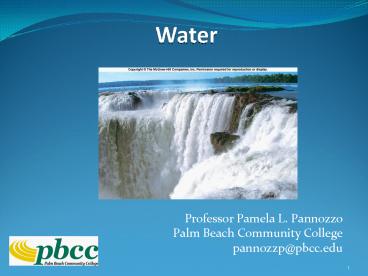Water PowerPoint PPT Presentation
1 / 41
Title: Water
1
Water
- Professor Pamela L. Pannozzo
- Palm Beach Community College
- pannozzp_at_pbcc.edu
2
Chatahoochee River, Georgia
- Issues
- Pollution
- Inequitable usage
- Future flows
3
Klamath River, Oregon
- Issues
- Reclamation for agriculture
- Salmon fishery
- Wildlife Refuges
4
Ganges River, India
- Issues
- Naturally occurring surface and groundwater
contamination
5
Water Distribution
6
Groundwater
7
(No Transcript)
8
(No Transcript)
9
Groundwater
- High-low pressure, downhill slow flow ( 1 m/day)
- 1.9 trillion liters pumped daily in U.S.
- Recharge slow
- Can be contaminated
- Landfill seepage, fertilizers, pesticides, septic
tank drainage, gasoline, etc. - Over consumption ? subsidence
- Sinkholes
- Saltwater intrusion
10
- Saltwater intrusion
- Contamination
11
The Ogallala Aquifer holds as much water, but
spreads over an area seven times the size of Lake
Huron. BLUE Unconsolidated sand and gravel
aquifers at or near the land surface. YELLOW
Semiconsolidated sand and gravel aquifers.
GRAY Sand and gravel aquifers of alluvial and
glacial origin are north of the line of
continental glaciation. Source USGS
12
Ogallala Aquifer
- ? Worlds largest
- ? 225,00 mile extent
- ? major water source for Midwest agriculture
industry - ? withdrawl currently exceeds recharge rate-- 40
ft drop 1980-994
13
Floridian Aquifer
- ? 100,000 mi2 extent
- ? Highly productive
- ? 3 billion gallon/day pumped
14
(No Transcript)
15
(No Transcript)
16
Biscayne Aquifer
- ? Unconfined coastal aquifer
- ? 4,000 mi2 extent
- ? Primary water source for SE Florida
- ? Highly permeablecontamination susceptibility
- ? Shallow aquifer 50-400 ft deep
17
Other Major Water Compartments
- Rivers/Streams
- Precipitation runs off the surface toward the sea
- Wetlands/Lakes
- Plant growth stabilizes soil, aquifer recharge
- Evaporation
- Vital role in hydrologic cycle
- Atmosphere
- 0.001 of total water supply
18
Water Quantity
- Consumption
- Agriculture 70--inefficient irrigation
- Industry 25
- Residential/municipal 10
- Uneven world-wide distribution
- Need for storage capabilities
19
Water Withdrawal
20
Ways to Increase Water Supplies
- Seeding Clouds ?
- Towing Icebergs?
- Desalination of ocean water ()
- Dams, Reservoirs, Canals
- Loss of wildlife habitat
- Pollution
- Domestic Conservation
- Watershed Management
- Retain/plant vegetation
- Hold water, Reduce flooding
21
Water Pollution
- Federal Water Pollution Control Act 1974
- Point Sources - Discharge from specific locations
- Factories, power plants, oil wells
- Non-Point Sources - Scattered discharge
- Agricultural fields, feedlots, golf courses
- Atmospheric deposition
22
(No Transcript)
23
(No Transcript)
24
Water Quality Today
25
Infectious Agents
- Coliform bacteria - Intestinal bacteria of
animals and humans (500 different types) - Escherichia coli (E. coli)
- Shigella
- Salmonella
- Listeria
- Animal wastes, human waste
26
Nutrient Pollution
- Fertilizers
- Nitrogen
- Phosphorous
- Oligotrophic low-nutrient water
- Eutrophic high-nutrient water
- Eutrophication human-caused increase of
nutrient levels and biological productivity - Depletes dissolved oxygenfish kills
- Red tides (toxins)
27
Water Oxygen Content
- Dissolved oxygen content
- gt 6 ppm supports desirable aquatic life
- lt 2 ppm oxygen--detritivores and decomposers
- Decreases in warm water, increases in cool water
- Sources of oxygen
- Wind, waves, photosynthesis
- Depletion of oxygen
- Cellular respiration
- Bacteria, algae
28
Oxygen Sag
29
Inorganic Pollutants
- Acids and Bases
- By-products of industrial processes
- Alter water chemistry (pH)
- Nonmetallic Salts (Ions) at toxic levels
- Stormwater runoff , evaporation
- Heavy metals --mercury, lead, cadmium, nickel
- Coal-buring power plants, mine leachate
- Bioaccumulate
- Neurotoxins
30
Organic Chemicals
- Used to make pesticides, plastics,
pharmaceuticals, pigments, etc. - Key sources of pollution
- Improper disposal of industrial, household wastes
- Pesticides run-off
31
Endocrine Disrupters
- Hormones and other organic chemicals mimicking
the action of hormones - Widespread through water-based disposal of
household pharmaceuticals worldwide - Late 1980s evidence of feminization of
reproductive organs in wildlife and humans - Lake Apopka, Florida alligators 1985
32
Sediment Pollution
- Caused by erosion
- Croplands primarily
- Smothers aquatic life, cloud waterways
- Lake Worth Lagoon muck
33
Thermal Pollution
- Industrial cooling discharges heated water back
into original source - Artificial environments may attract wildlife
- ManateesRiviera Beach FPL plant, LWL
- Can adversely affect water quality and aquatic
life - Oxygen solubility decreases as temperatures
increase
34
Groundwater Pollution
35
Ocean Pollution
- Est. 6 million tons of plastic bottles, packaging
material, and other litter annually - Oil or oil products
36
Wastewater Treatment
- Septic systems
- Municipal sewer systems
- 1--Removal of suspended solids (60)
- 2--Aerobic bacteria degrade suspended solids
- Constructed wetlands, reclaimed (gray) water
- 3Effluent pumped into rivers/ocean OR bacteria
killed through chorination/UV - Reclaimed water
37
(No Transcript)
38
Water Treatment
- Standards set by EPA
- Enforced by monitoring
- Issues
- Pipes (lead, copper)
- Public health additives (fluorine)
- Bone disease
- Disinfectants and by-products (chlorines)
- Bioaccumulants, carcinogens, neurotoxins
- Pharmaceutials
- Unknown effects
39
(No Transcript)
40
Water Purification
- Removal of sand, sediments, bacteria, protists,
viruses, minerals, toxic metals, salts - Methods
- Filtration, ultrafiltration--solids
- Water softeningmetal ions--ions exchange resins
- Reverse osmosissemipermeable membrane
- Distillation--boiling
- Deionizationresins remove ions
- Powdered activated carbon treatmentsuspended
solids - Disinfectionchlorine, ozone, ultraviolet light
41
(No Transcript)

